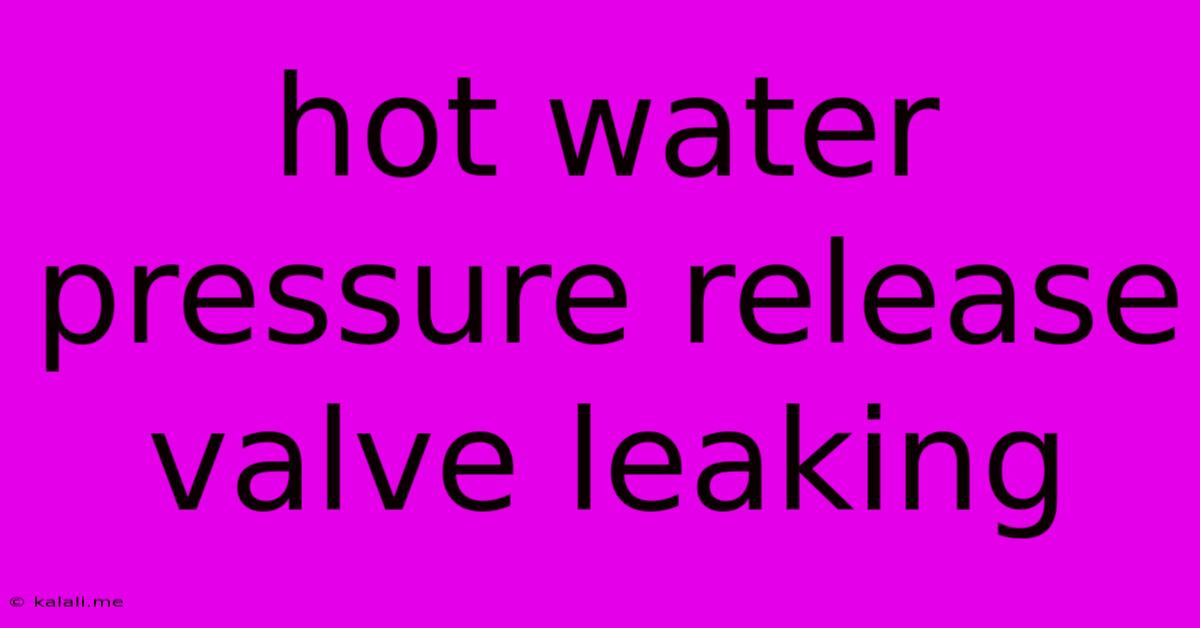Hot Water Pressure Release Valve Leaking
Kalali
May 20, 2025 · 3 min read

Table of Contents
Hot Water Pressure Release Valve Leaking: Troubleshooting and Solutions
A leaking hot water pressure release valve is more than just an annoying drip; it signals a potential problem with your water heater's pressure regulation. This issue can lead to water damage, wasted energy, and even more serious problems down the line. Understanding the cause of the leak and how to address it is crucial for maintaining the safety and efficiency of your hot water system. This guide will walk you through common causes, troubleshooting steps, and effective solutions.
Understanding the Hot Water Pressure Relief Valve
The pressure relief valve (PRV), also known as a temperature and pressure relief valve (T&P valve), is a vital safety device on your hot water heater. It's designed to release excess pressure or temperature that could potentially cause the tank to rupture. This prevents dangerous and costly water damage. A small leak is sometimes normal, but a significant drip or steady stream indicates a problem needing attention.
Why is My Pressure Relief Valve Leaking?
Several factors can contribute to a leaking hot water pressure relief valve:
1. Excess Pressure: This is the most common cause. High water pressure from your municipal supply or a malfunctioning pressure regulator can overload the valve, forcing it to release water.
2. Mineral Buildup: Over time, mineral deposits (lime scale) can accumulate inside the valve, hindering its proper functioning and causing it to leak.
3. Valve Wear and Tear: Like any mechanical device, the PRV can wear out with age and use, leading to leaks. The internal components might become damaged or corroded.
4. Temperature Fluctuations: Extreme temperature changes can put stress on the valve, potentially causing a leak.
5. Faulty Water Heater: Problems within the water heater itself, such as a malfunctioning thermostat or a leak in the tank, can also cause pressure buildup, leading to the PRV leaking.
Troubleshooting Your Leaking Pressure Relief Valve
Before attempting any repairs, always turn off the power or gas supply to your water heater.
-
Check the Water Pressure: Use a pressure gauge to measure the water pressure entering your home. If it's excessively high (above 80 psi), contact your local water utility. They may need to adjust the pressure at the street.
-
Inspect the Valve for Debris: Carefully examine the valve's discharge pipe for any obstructions. Clear any debris if found.
-
Check for a Steady Leak: A slight drip after hot water use is sometimes acceptable. However, a constant stream requires attention and likely indicates a problem.
-
Test the Valve: Manually lift the lever on the valve. Water should flow freely if pressure is present. If not, the valve may be stuck or needs replacement. Remember to replace the lever after testing.
-
Listen for Unusual Noises: Unusual hissing or banging sounds from the water heater can indicate other internal problems that may be contributing to the excess pressure.
Solutions for a Leaking Pressure Relief Valve
If your troubleshooting reveals a malfunctioning valve, replacement is usually the best solution. It's a relatively straightforward task, but if you're not comfortable working with plumbing, call a qualified plumber.
Replacing the Pressure Relief Valve:
- Turn off the water heater and water supply.
- Drain some hot water from the tank to relieve pressure.
- Disconnect the discharge pipe from the valve.
- Carefully remove the old valve using appropriate tools.
- Install the new valve, ensuring a tight seal.
- Reconnect the discharge pipe.
- Turn the water supply back on and check for leaks.
- Turn the water heater back on.
Preventing Future Leaks:
- Regularly inspect your PRV for any signs of leaks or damage.
- Consider a pressure regulator to maintain consistent water pressure.
- Flush your water heater periodically to remove mineral buildup.
- Maintain your water heater according to the manufacturer's instructions.
A leaking hot water pressure relief valve shouldn't be ignored. Addressing the issue promptly prevents costly water damage and ensures the safe operation of your water heating system. By following these troubleshooting steps and solutions, you can restore the functionality of your valve and maintain a safe and efficient home. Remember, if you're unsure about any step, call a qualified plumber.
Latest Posts
Latest Posts
-
3 Prong To Two Prong Adapter
May 21, 2025
-
Wiring A Ceiling Light With 4 Wires
May 21, 2025
-
What Does Kip Mean On Snapchat
May 21, 2025
-
Chirping Smoke Detector After Replacing Battery
May 21, 2025
-
How Did Gibbs Get The Boat Out Of His Basement
May 21, 2025
Related Post
Thank you for visiting our website which covers about Hot Water Pressure Release Valve Leaking . We hope the information provided has been useful to you. Feel free to contact us if you have any questions or need further assistance. See you next time and don't miss to bookmark.